|
Important Notice:
An update of this review can be found at okgourmet.com . |
Matsuharu Japanese Restaurant
4886 Hercules Ave.El Paso, TX
(915) 751-9355

If there was ever a hidden gem in El Paso, I believe Matsuharu is it. Located off the street in an obscure
strip mall on a little traveled street, Matsuharu Japanese Restaurant is not
very obvious from the street and many long time residents may not even know it exists. Customers
seem to come due to word of mouth, or possibly some people remember the Ginza Japanese
Restaurant that operated for years at the same location.
I believe a major factor that keeps Matsuharu in business is its popularity with the Japanese
population in both El Paso and Ciudad Juarez who are in the area as a result of the maquila
(twin plant) industry. Just as in Seattle, where one of the best guides to a Japanese restaurant's quality
and authenticity is the number of Japanese customers it attracts, the same is true in El Paso. While I
see Japanese business people and other customers at the other restaurants, Matsuharu seems to
be the most popular and attracts the most loyal following.
Matsuharu frequently hosts large parties from the Japanese companies, and while this makes
the kitchen very busy, they still provide the same friendly service to other customers who come in. I
believe the large parties provide a great opportunity to expand a person's experience in
Japanese cuisine, and this is a good time to ask the staff if any special dishes are being prepared
that evening for the large party that can also be served to other customers. Sometimes the chefs
will prepare special dishes and sometimes it is just a matter of ordering something the restaurant
makes available all the time but which may be a new dish to you.
There are plenty of choices on the menu that I think will keep me satisfied for a number of visits.
These include noodle dishes, appetizers, meats, fish, soups, and much more. Sushi is available,
but the owner, who serves as both one of the regular chefs and the sushi chef, keeps the selection
small so that good quality can be maintained. Matsuharu strives to provide all different types of
Japanese cuisine, and to provide much the same experience as a person would receive at a
high quality restaurant in Japan.
A Japanese menu is available if you want to expand your horizons beyond the regular menu.
The supplemental menu is not an attempt to keep certain items "secret," but rather that certain items
do not translate well into English and the management would rather explain them verbally than try to
do so on the menu. I think this may be particularly true with certain types of fish that are familiar to
Japanese people but are not well known in the U.S.
The fish at Matsuharu is flown in from Los Angeles, and this makes it some of the freshest in El
Paso (and I was informed that the fish used for sushi is never frozen before being used). It seems
to me that the owner has always put a high priority on serving fish that is worthy of representing the
cuisine of a nation that largely lives off of its fishing industry.
When many people think of Japanese restaurants, Sushi is the first thing that comes to
mind. Personally, there are so many other Japanese dishes I love that I rarely make a meal
exclusively out of sushi. Nevertheless, Matsuharu offers enough choices to provide a sushi feast
if that is the customer's desire.
A couple of the Japanese restaurants on the east side make good California rolls, but even
if the one at Matsuharu is better (which I suspect it may be), this is not something I consider to be the
ultimate sushi test.
Since I usually order nigiri style sushi, I tried the Hamachi, or yellowtail
at Matsuharu. This is a light fish similar to tuna, and has been described as having a buttery taste.
I thought the one here was good quality fish, and most likely came from Japan where the more
desirable varieties of yellowtail are found. It did show some signs of losing some of its freshness
through the transportation process, as I would expect in a city that is so far from the ocean and from
major distribution centers. The flavor and preparation, though, were excellent. Overall I would say it
was about in line with others I have tried in good sushi restaurants in the Southwest.
Unagi, or fresh water eel, was an even better nigiri selection. This variety is
cooked and then served as sushi. I thought this was the standout of the sushi I tried at Matsuharu,
with an excellent flavor and a freshness that I would expect to find in many of the best U.S. restaurants.
Omakase is the practice of asking the sushi chef to serve the best selections the restaurant has
to offer, and I appreciated the chef's suggestion of this dish.
My introduction to the fish at Matsuharu was the cooked Salmon Teriyaki dish, a type of
fish I have ordered at other Japanese restaurants in the city as well as out of town. This salmon had
a good flavor and red color that made me think at first that the restaurant had a special supply line
from the fish markets on the Pacific coast. Now I think the fish is shipped normally, but they simply
buy a higher quality fish than is usually found. The sauce was not too sweet, something that downgrades
many teriyaki dishes that are otherwise good. This is still one of my favorite dishes at Matsuharu
even though El Paso probably does not have the same varieties of salmon that can be found in the
Pacific Northwest.
The Salmon I tried without teriyaki sauce was of equal quality, with a fatty type of fish
served that had a good flavor. It did not seem to be Alaskan King, but it was probably the next
step down in redness and flavor, which to me is more than acceptable.
Tempura Udon has been one of the best dishes at Matsuharu, and I prefer it to the others
served in El Paso. The dark broth had a deep, rich flavor that is seldom found in restaurants,
so even if the other components fell short it would still be enjoyable. The noodles, though, tasted
fresh, and the tempura was of such high quality that I think it may even stand out more than the
broth. The Vegetable Tempura contained a mixture of fresh vegetables cooked together
that made it one of the most enjoyable I have ever experienced. The Shrimp Tempura was
fresh and non-greasy. The batter on the shrimp was quite different than I frequently find, and
was more suitable for dipping into the soup than others that are more flaky and that fall apart when
served in the soup. Although I like some of the others served in El Paso, the one at Matsuharu
seems to be more traditional and is definitely the one I would recommend.
Tempura Soba is made the same way as the udon, only with dark noodles
that I found to be even more enjoyable than the udon dish. So far I think this is the one dish
I have enjoyed the most at the restaurant. Of course, one of the great things about Matsuharu (and
most Japanese restaurants) is that meals do not usually consist of just one item, but usually come
with soup or appetizers. Both the tempura soba and tempura udon, though, are
fairly complex soups that really make a meal in themselves.
Nabeyaki Udon is another style of noodle dish that provides all the elements for a
balanced meal: wheat noodles, shrimp tempura, egg, fishcake, green onions, and mushroom.
I found it to be much like the tempura udon but with extra ingredients, making it extra good.
The shrimp tempura alone would make it worthwhile, and the broth has the light flavor I find in
a lot of the better soups.
Ramen is not a dish I see frequently in Japanese restaurants, and when places such
as Matsuharu serve it, this indicates to me that they have a greater than average skill in preparing
traditional Japanese cuisine. Matsuharu actually serves three styles of ramen, and after trying
one of them I am quite anxious to taste the other two.
Wikipedia indicates that different styles of ramen
are popular in different regions of Japan, and that all ramen soups have their origins from Chinese
noodle soup. While a bowl of soup may not sound as if it would make a substantial meal, the ramen
here (and at other good Japanese restaurants) provides a balance of ingredients, flavors, and
textures to leave just about anyone satisfied. I particularly liked the soy sauce based broth
that brought flavor to the noodles and everything else that was packed into the bowl (including egg,
spinach, and pork). The other two varieties of ramen at Matsuharu are miso ramen, made
with a bean paste soup, and ankake ramen cooked with pork and bean sprouts with potato
starch. There are two types of pepper on the table that are meant to enliven the different soups
that are served, if the customer is so inclined.
Tonkotsu Ramen was a "special dish" in the sense that it was not listed on the menu, but
it is available on request. This was an excellent ramen made with pork broth, ramen noodles, and
had a ginger flavor in the broth. I thought it was equal in quality to the other ramen, but provided a
variety to give patrons an even greater exposure to Japanese food.
Miso Soup comes with some meals and costs extra with others. This is definitely top quality,
as will be very evident if you have ever gone to restaurants that seem to make it from a mix.
Appetizers are always included, although they have varied between visits. The
complimentary ones I have received have not been as outstanding as the miso soup,
but some very good appetizers are available on the menu and as special dishes.
Green Tea is served free with every meal, and is hard to beat. Matsuharu also serves
an iced green tea drink that is surprisingly delicious, and great during the summer.
Special Dishes
Many of my best experiences at Matsuharu have come from ordering the same things I see
at other tables, primarily when there is a large group of people who order specials or items from
the Japanese menu. I think the majority of the food, including the specials, is available anytime.
It is just a matter, though, of knowing what to order and knowing if you would like it after you order it.
With Japanese food it seems to help a lot if you can see it first. I normally think it is impolite to
look at other people's food in order to "check it out," but when Matsuharu hosts a large party there
is usually a discreet and polite way to ask other patrons for their recommendations.
One of the all time best dishes here was a Japanese Flounder from the Japanese menu
whose proper name I do not know. The owner said it is similar to the flounder from American waters
only with the eyes on the opposite side This fish was fresher than the salmon, cooked to perfection,
and had a wonderful flavor (I even ate the skin--I don't know if it was because the fish was so good
or because it was cooked so expertly). I find it a little amazing that many Americans prefer white fish
fillets to many of the more flavorful fish typically served in Asian restaurants and around the world.
If the idea of a whole fish with the bones intact does not appeal to you then this is not a good choice,
but it is one type of fish I enjoy when I can get it.
For those who do like white fish, a Hokke fillet is also available, and is good quality.
To me it was more the light cooking style that made this fish desirable than the fish itself, but it
is something I would order again if I were not in the mood for salmon or one of the darker fishes.
An order of Red Snapper that I tried on one visit did not taste as good to me as the
others I orderd, but is still something I would recommend.
Chanpuru, an appetizer made of tofu and bean sprouts was an excellent appetizer
that the restaurant made for a large party, and was available to other customers as well. I do
not generally care much for bean sprouts, but this had quite a surprisingly good flavor, being
stir fried with a soy sauce seasoning. "Chanpuru" is a general name given to dishes from
Okinawa that are stir fried with vegetables and tofu, and I am very glad I got to try Matsuharu's
version. The miso soup, salad, and other appetizers I have tried have led me to
the conclusion that the dishes served before the main meal are an integral part of the high
quality found at Matsuharu.
The restaurant recently started opening all day on Saturday and Sunday, so it is now
possible to go for lunch on weekends. Tempura and sushi are not served at lunch, but the
selection is still quite extensive. I would say Matsuharu is very serious about its food, as is
shown by the very expert ramen, tempura, and other dishes that are served. I think most people
who try it for the first time will be sorry they have missed it for so long.
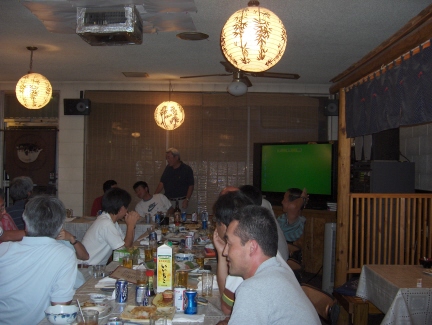
Large parties come to enjoy an Izakaya style meal and some karaoke
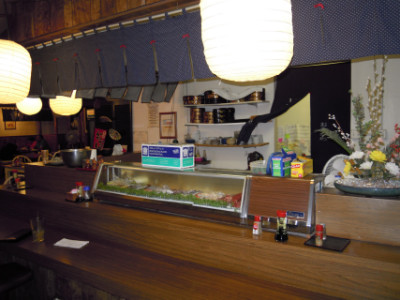
Matsuharu's sushi bar
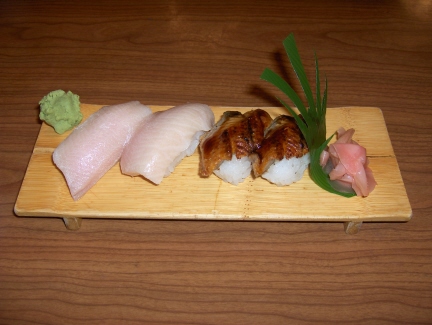
Sushi with Hamachi and Unagi
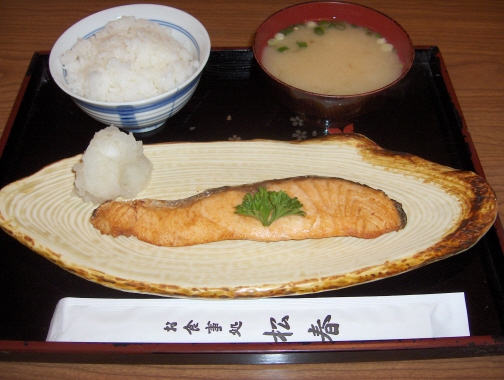
Salmon plate
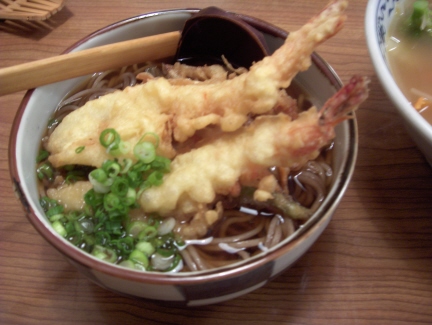
Tempura soba with shrimp
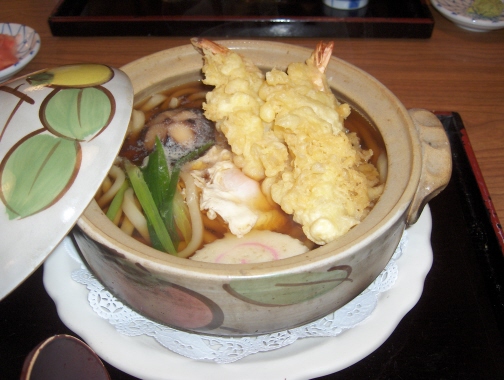
Nabeyaki Udon with shrimp tempura, egg, fishcake, green onions, and mushroom on wheat noodles

One of the three types of ramen served at Matsuharu
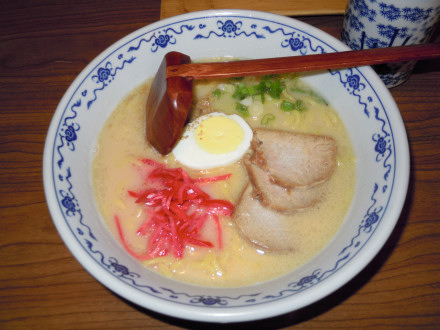
Tonkotsu ramen
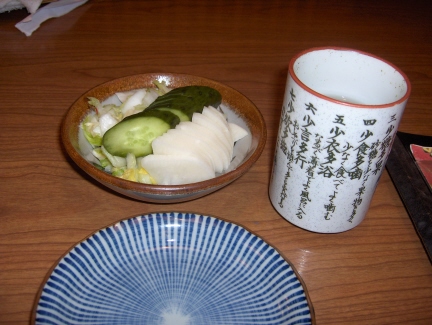
Oshinko appetizer
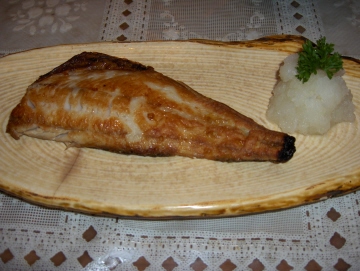
Hokke from the Japanese menu
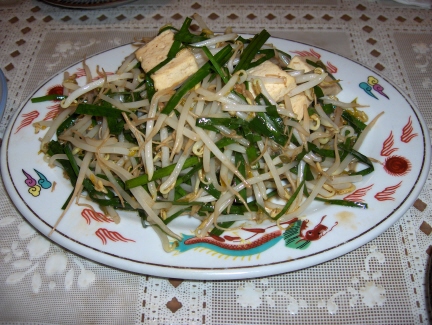
Chanpuru appetizer of tofu and bean sprouts
Go to Index
RESTAURANT DETAILS
RATING: 24
Cuisine: Japanese
Cost: $$
Hours: Dinner Tue.-Sun.; Lunch Sat. & Sun.
Accessible: Yes
Tea: Green (brewed) House
MSG: No
Smoking: No Smoking
Alcohol: Beer, Sake
Most Recent Visit
Aug. 27, 2010
Number of Visits: 9
Best Items
Whole Fish, Tempura Udon, Tempura Soba, Ramen, Salmon Teriyaki, Miso Soup, Appetizers
Special Ratings
Salmon: 
Salmon Teriyaki: 
Whole Fish:  from the Japanese menu
from the Japanese menu
Ramen: 
Tempura Udon: 
Tempura Soba: 
Nabeyaki Udon: 
Miso Soup: 
Chanpuru: 
MORE ABOUT THIS WEB SITE
Top Rated Restaurants
List of Top Rated Restaurants
Restaurant Rankings
Oklahoma
El Paso, Texas
Washington State
Links
Links and Additional Sources
Blog
Blog Index